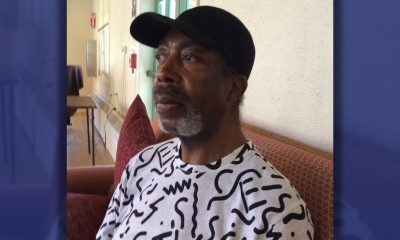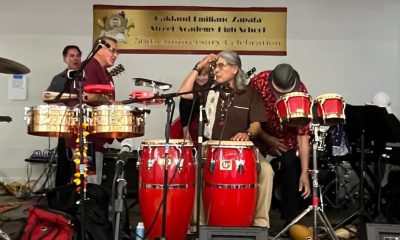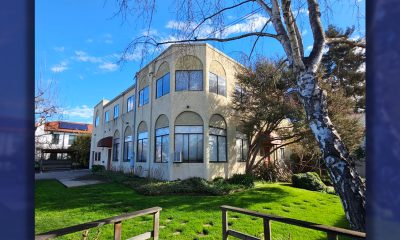Education
School District Faces Conflict Over Teacher Pay and “Redesign” of Five Schools
The Oakland Unified School District’s three new school board members and newly hired superintendent have taken their positions just as two of the district’s most protracted conflicts are coming to a head – poorly paid teachers who are demanding decent pay and job security, and communities at five schools that are fed up with district-led reorganizations that have repeatedly disrupted and destabilized their schools over the last decade.
 
Most everyone agrees that Oakland’s teachers desperately need a raise. According to the teachers’ union, they are the lowest-paid in Alameda County and lowest-paid in the nine-county Bay Area.
As a result, the district has a 20 percent turnover rate each year, meaning the schools are stuck on a treadmill – hiring and recruiting mostly untrained teachers.
Angry teachers came out in force Wednesday night, marching down Park Boulevard to rally and speak at this week’s Board of Education meeting at La Escuelita Education Center.
In protest, teachers at many schools are staging a slowdown, called “work to rule,” coming at the beginning of the school day and leaving when school ends, not giving or correcting homework or doing any of the myriad other tasks they generally do.
The district is offering a 10 percent raise over three years – 3 percent this year, starting in January; 3 percent next January; and 4 percent the following year, depending on the funds that come from the state.
Oakland Education Association (OEA) President Trish Gorham says the mid-year 3 percent raise this year does not keep up with the 3.25 percent other Bay Area teachers have received.
“That just makes us fall further behind,” she said.
Supt. Antwan Wilson responded to teachers at the meeting and in an email to the school community.
“We need to finalize these negotiations so that we can focus all of our energy on the work that is before us to ensure quality schools for all – and there is a lot of work to do,” he wrote.
“I remain committed to making Oakland the leader in attracting, retaining and rewarding the best talent,” he continued. “While this vision cannot be achieved overnight, it is possible.”
He pointed to the constraints the district is facing. “We can’t forget that California remains 46th out of 50 states in per pupil spending.” Further, he said the district still has to pay $6 million per year to the state to repay the $100 million bailout OUSD received when it went into bankruptcy and was taken over by the state in 2003.
In addition to salaries, OEA President Gorham says teachers are concerned about the district’s desire to weaken teacher transfer provisions in the contract, allowing the administration to unilaterally and involuntarily transfer teachers from schools and weaken seniority rights to open positions.
The three high schools facing “redesign” this year – Fremont, McClymonds and Castlemont – were reconstituted three years ago, and every teacher had to reapply for their job.
Now the district is going to do it again, Gorham said. “Where is the analysis of what they did then? What is going to happen to the teachers who don’t want to leave their school sites and are forced to leave?”
The administration and the school board have admitted that they have to do a better job explaining their plans to “transform” five “failing” schools this year – Brookfield Elementary and Frick Middle schools, in addition to the two East Oakland and one West Oakland high schools.
Most everyone agrees that Oakland’s schools must make deep changes in order to improve graduation rates and post-secondary admission rates, particularly for African American and Latino students.
But questions and concerns remain. A group of students from Fremont High and other schools came to this week’s board meeting to oppose the plan. A group from the McClymonds community called on the district to explain what it is planning and to include the community in making the changes.
The districts plan calls for an open competition period to submit to school redesign proposals, starting in February. Charter schools and other outside organizations are eligible to apply to run the schools.
This approach was adopted by the school board in 2013 and re-approved in 2014 under the leadership of then Board President David Kakishiba and acting Supt Gary Yee. Supt. Wilson was hired to implement it.
District spokesman Troy Flint told the Post that no school would be forced to become a charter over community opposition. If a school is opposed to “the idea of charter, it would naturally follow that a charter proposal would not prevail in the selection process at that particular school,” he said.
State law permits groups of parents or teachers at individual schools to apply to become a charter, said Gorham. But the district is adopting a different approach: open up a competition for charters to submit applications, and the board and superintendent will make the decision.
According to Gorham and others, the district approach dooms the existing schools. “If you publically call them ‘failing schools,’ how many parents are going to enroll their kids in the schools next year?”
“It’s a self-fulfilling prophecy. You destabilize, reconstitute, and then you convert to charter,” said Gorham.
Instead, a number of the opponents of the plan say the district should listen respectfully with the school communities, find out what they need, and pour in resources and other support to make them schools that students want to attend and where parents want to send their children.
Flint denied that anyone at OUSD referred to the schools as failing.
“I’m not aware of anyone publicly referring to these schools as ‘failing schools’. Perhaps this was mentioned at a meeting I didn’t attend, but that’s not what we’ve been saying in our official communications,” he wrote to the Post. “We do refer to patterns of relatively low academic performance and under-enrollment.”
Activism
S.F. Black Leaders Rally to Protest, Discuss ‘Epidemic’ of Racial Slurs Against Black Students in SF Public School System
Parents at the meeting spoke of their children as no longer feeling safe in school because of bullying and discrimination. Parents also said that reported incidents such as racial slurs and intimidation are not dealt with to their satisfaction and feel ignored.

By Carla Thomas
San Francisco’s Third Baptist Church hosted a rally and meeting Sunday to discuss hatred toward African American students of the San Francisco Unified School District (SFUSD).
Rev. Amos C. Brown, president of the San Francisco NAACP and pastor of Third Baptist Church, along with leadership from local civil rights groups, the city’s faith-based community and Black community leadership convened at the church.
“There has been an epidemic of racial slurs and mistreatment of Black children in our public schools in the city,” said Brown. “This will not be tolerated.”
According to civil rights advocate Mattie Scott, students from elementary to high school have reported an extraordinary amount of racial slurs directed at them.
“There is a surge of overt racism in the schools, and our children should not be subjected to this,” said Scott. “Students are in school to learn, develop, and grow, not be hated on,” said Scott. “The parents of the children feel they have not received the support necessary to protect their children.”
Attendees were briefed last Friday in a meeting with SFUSD Superintendent Dr. Matt Wayne.
SFUSD states that their policies protect children and they are not at liberty to publicly discuss the issues to protect the children’s privacy.
Parents at the meeting spoke of their children as no longer feeling safe in school because of bullying and discrimination. Parents also said that reported incidents such as racial slurs and intimidation are not dealt with to their satisfaction and feel ignored.
Some parents said they have removed their students from school while other parents and community leaders called on the removal of the SFUSD superintendent, the firing of certain school principals and the need for more supportive school board members.
Community advocates discussed boycotting the schools and creating Freedom Schools led by Black leaders and educators, reassuring parents that their child’s wellbeing and education are the highest priority and youth are not to be disrupted by racism or policies that don’t support them.
Virginia Marshall, chair of the San Francisco NAACP’s education committee, offered encouragement to the parents and students in attendance while also announcing an upcoming May 14 school board meeting to demand accountability over their mistreatment.
“I’m urging anyone that cares about our students to pack the May 14 school board meeting,” said Marshall.
This resource was supported in whole or in part by funding provided by the State of California, administered by the California State Library via California Black Media as part of the Stop the Hate Program. The program is supported by partnership with California Department of Social Services and the California Commission on Asian and Pacific Islander American Affairs as part of the Stop the Hate program. To report a hate incident or hate crime and get support, go to CA vs Hate.
Community
ELITE Charter School Conducts Sit-In Protest at Vallejo City Hall After City Council Vote
ELITE Public School staff and students staged a sit-in at Vallejo City Hall on Wednesday afternoon to protest the City Council’s decision to vote against their Major Use Permit to expand into downtown. “We are deeply troubled by the turnover of the 6-1 vote, which we believe to be red-lining in 2024,” said Dr. Ramona Bishop, CEO of ELITE Public Schools.

By Magaly Muñoz
ELITE Public School staff and students staged a sit-in at Vallejo City Hall on Wednesday afternoon to protest the City Council’s decision to vote against their Major Use Permit to expand into downtown.
“We are deeply troubled by the turnover of the 6-1 vote, which we believe to be red-lining in 2024,” said Dr. Ramona Bishop, CEO of ELITE Public Schools. “We have followed all the requirements set forth for approval by the city and are dismayed by this sudden reversal of fortune. Our sit-in at City Hall is a testament to our unwavering commitment to justice and fairness.”
The sit-in was triggered after the Vallejo City Council members held a lengthy, special meeting on Tuesday evening to continue discussing the April 23 appeal that was made against the Planning Commission’s decision to grant ELITE a permit for expanding their charter high school into a retrofitted building in the heart of downtown.
During the deliberations, various options were presented to the Council for approving the project. These included a provisionary review period for the permit and imposing extensive conditions, such as limiting student enrollment.
The ELITE plan was to accommodate a maximum capacity of 400 students at their proposed school site, starting with an initial rollout capacity of 200 students in the first year.
Bishop rejected the suggestion by the City Council for a smaller charter capacity because the funding for the school was based on the projected number of students they would eventually seat.
During the meeting, council members complained about the lack of availability of economic impact reports that assessed the school’s potential impact on Vallejo’s downtown area.
Economic Development Director Michael Nimon sent a letter to the City Council, stating that while there was no official report, schools serve as economic generators to the surrounding areas of where they’re located.
“Schools also diversify uses and create pedestrian activity by bringing more people to downtown. Diversification of uses makes local economy more resilient by balancing residential, commercial, office, entertainment, and institutional uses,” Nimon’s letter said.
The letter also states that foot traffic is needed in an area of Vallejo that currently has minimal activity and the presence of the proposed school will likely not disturb any future developments.
Despite this, the council dismissed the letter as “merely an opinion” and not anything based on fact or concrete data.
Councilmember Peter Bregenzer, who remained silent throughout most of the seven-hour discussion, ultimately motioned for City staff to draft a resolution to approve the appeal and deny the project. The motion passed by a 4-3 vote.
About 50 students gathered on the second floor of the City Hall building where they chanted “Say it loud, say it clear, we don’t want no racists here” and “Where is the mayor? Bring him out, bring him out.”
The proposed high school has sparked intense debate, with many speculating that those opposed to the school are saying no to the expansion because the majority of the students are Black and Brown.
Retired Solano County Judge Paul Beeman and his wife, Donna, who filed the appeal against the school, have consistently denied that their opposition stems from racism or personal feelings toward anyone associated with the school.
In interviews with the Post, the Beemans seem to regard the proposed high school as a “nuisance” and an ill-advised choice for downtown development. They claim that it would be ineffective in economically revitalizing the community. However, they have provided no substantial evidence to support their opinions.
In contrast, ELITE has drawn parallels to redlining in relation to the community’s opposition to the proposed school location. Redlining refers to the discriminatory practice in which mortgage companies and other financial services systematically withhold loans and access to predominantly white neighborhoods from racial and ethnic minorities, particularly Black and African American communities.
“We’ve been fighting for this school for two years. We’re going to make our emergency, their emergency,” one student said in reference to Vallejo Mayor Robert McConnell’s previous comments about not rushing to make a decision on the school permit.
Within two hours of the start of the sit-in at City Hall, the City of Vallejo issued a statement that the building would be closed for the rest of the day because of the protest. The statement said that the loud noise from the protesters “hindered staff and visitors’ ability to conduct regular business.”
Although the mayor was not present at City Hall on Wednesday afternoon, interim City Manager Beverli Marshall addressed the ELITE group to answer several questions the students had. She explained the appeal process, how the different city officials played a role in the decision, and what the possible outcomes could be after the Council makes its final decision in a few weeks.
Students and staff were ultimately upset that they were being treated like criminals and that all their work over the last two years might be in vain since they believed that the Council had zero intention of ever granting them the permit in the first place.
The City Council is scheduled to meet for another special meeting on June 4 at 7 p.m. to continue discussing the future of ELITE Public Schools.
Community
Salesian Coach Knew Angel Jackson Could Play in WNBA
Back in 2019, Salesian Girls Basketball Head Coach Stephen Pezzola made a bold prediction about one of his players, Angel Jackson. “If she keeps putting in the work like she did for us, she could be in the WNBA,” the coach said. That turned out to be very true. Last month, the Las Vegas Aces selected Jackson with the 36th overall pick in the 2024 WNBA Draft. She is the second player from an Historically Black College or University, or HCBU, to be selected in the draft in 20 years.

The Richmond Standard
Back in 2019, Salesian Girls Basketball Head Coach Stephen Pezzola made a bold prediction about one of his players, Angel Jackson.
“If she keeps putting in the work like she did for us, she could be in the WNBA,” the coach said.
That turned out to be very true. Last month, the Las Vegas Aces selected Jackson with the 36th overall pick in the 2024 WNBA Draft. She is the second player from an Historically Black College or University, or HCBU, to be selected in the draft in 20 years.
Jackson’s success came as little surprise to Pezzola, who last year led the Pride to their 8th North Coast Section championship since he took over the program in 2008-2009. In 2019, Pezzola commended Jackson as “a very coachable kid” from the time she arrived at Salesian.
Tomekia Reed, her coach at Jackson State, shared similar sentiments, noting Jackson worked “very hard” to reach this moment.
“She came into our program doing great things and never looked back,” Reed told the Clarion Ledger. “She has trusted our leadership as we were able to develop her into an amazing player. I have watched her improve tremendously over the years.”
The 6’-6” Jackson played three seasons at the University of Southern California before transferring to Jackson State. She was ranked 10th in the NCAA in blocked shots and averaged 10 points per game in her final college season.
She finished her collegiate career with 1,047 points and was twice named Southwestern Athletic Conference Defensive Player of the Year.
As the 36th pick, Jackson was the final pick in the 2024 NBA Draft. In a television interview, Jackson said she didn’t expect to be picked, and called the moment “surreal.”
“It made me feel so appreciative that HBCU is getting back on the map again,” she said.
All she could do in that moment was cry.
“I called my mom immediately, and she started crying,” Jackson said. “It was the best moment you can feel as a young lady.”
There’s no stopping Jackson now. “The sky is the limit,” she said.
Her high school coach agrees.
“I knew that Angel could do it,” Coach Pezzola told the Richmond Standard this week. “We are so proud of Angel and what she has accomplished. It was an honor and joy to coach Angel at Salesian.”
-

 Community3 weeks ago
Community3 weeks agoFinancial Assistance Bill for Descendants of Enslaved Persons to Help Them Purchase, Own, or Maintain a Home
-

 Business3 weeks ago
Business3 weeks agoV.P. Kamala Harris: Americans With Criminal Records Will Soon Be Eligible for SBA Loans
-

 Activism3 weeks ago
Activism3 weeks agoOakland Post: Week of April 10 – 16, 2024
-

 Community3 weeks ago
Community3 weeks agoAG Bonta Says Oakland School Leaders Should Comply with State Laws to Avoid ‘Disparate Harm’ When Closing or Merging Schools
-

 Activism1 week ago
Activism1 week agoOakland Post: Week of April 24 – 30, 2024
-

 Community2 weeks ago
Community2 weeks agoRichmond Nonprofit Helps Ex-Felons Get Back on Their Feet
-

 Community2 weeks ago
Community2 weeks agoOakland WNBA Player to be Inducted Into Hall of Fame
-

 Community2 weeks ago
Community2 weeks agoRPAL to Rename Technology Center for Retired Police Captain Arthur Lee Johnson





















































